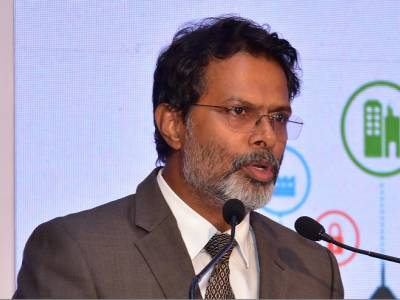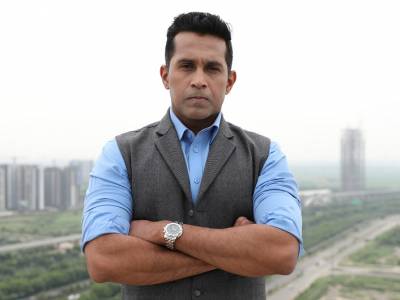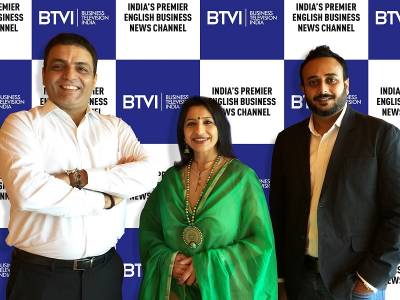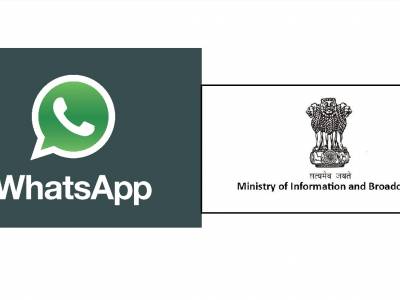Business news genre is very limiting from a revenue standpoint: Anil Uniyal
Located in one of the plush, busy corporate lanes of Mumbai’s Lower Parel area, Bloomberg|Quint’s office is far more different than any usual news service providers’. Ditching the boxed set-ups and cabins, the premier business and financial news brand has imbibed an open space office culture for easy flow of information and communication.
Bloomberg|Quint launched its digital live streaming service in India a few months back. Available on www.bloombergquint.com, the comprehensive service offers regular live programming taking place on a daily basis, covering myriad topics ranging from global and domestic markets issues to the issues concerning most influential newsmakers in business and finance. The brand crossed 1 million monthly users on its platform within 6 months of going live and a month after exiting its beta phase.
At the helm of Bloomberg|Quint is its CEO, Anil Uniyal. Considered a pioneer of business news in India, Uniyal has in-depth expertise in building and scaling branded solutions in the category, thanks to a successful entrepreneurial stint in advertising and promotions early on in his career. He was instrumental in shaping and growing the CNBC network from a valuation of a few crores to a behemoth business news brand worth Rs 400 crore. During his association with Network18 Media, Uniyal also turned Forbes India around into a profitable business within a year of taking charge.
In conversation with Adgully, Anil Uniyal, CEO, Bloomberg|Quint, speaks at length about the Bloomberg and Quint’s partnership, content strategy for the live streaming service, programming line-up, revenue-growth, views on fake news and much more. Excerpts:
How is the Bloomberg and Quint partnership shaping up?
This is the first time that Bloomberg has gotten into a joint venture in India, wherein they have a stake in the business. Before that, that was not the case. It was more of a licensing arrangement, where you end up getting a royalty out of that. And I think that is true for most of the international brands in India.
In this case, what’s happening is that it also starts depicting the seriousness of the player. When somebody is having a stake in the business, that means their skin is in the game. So there’s a sort of commitment that has come by. Bloomberg has had a couple of partnerships here in the past, but they didn’t have the desired outcome.
Bloomberg|Quint is a 74-26 partnership venture, where Raghav Bahl’s company Quintillion Media helms 74 per cent and the remaining 36 per cent is with Bloomberg. It is because of the nature of the partnership that the entire approach has also changed. You have access to the best practices across the world, best 4k reporters, deepest access to Bloomberg Terminals, which, though an institutional product, is a goldmine of data and insights. From the arrangement standpoint, I don’t think there could have been any better partnership than Bloomberg and Quint.
Who have been some of your key clients?
In the last 6-8 months, we have signed on 20-25 clients who are thrilled with our partnership. They include GE, American Express, Dell, MRF, and HP, among others. We have done a bunch of stuff for them like an article or video piece, an infographic or a mix of both, an inventory, etc. In digital, you are able to track what your deliverables are, which is one of the reasons why the world is moving towards digital. We hope there will soon be a day when there will be no wastage and no voiceover giving you the consumption. It is the profile of the client that we bring to the table; from the content standpoint, it is standing apart in what exists in the Indian market today, which builds confidence in the clients and that’s what thrills them. We have more tech-based clients as these are the natural fit for the business news industry.
What has the revenue growth been like for Bloomberg|Quint?
We have just started 7-8 months ago and have a decent size of clients. Our business plans were made keeping TV in mind, but still we are on course. From a business standpoint, the numbers are comfortable.
What is your current reach and who comprises your TG?
Typically looking from a geographical breakup, it is 1 million-plus towns. But looking at it from the TV perspective, maximum viewership is coming from the 6 metros followed by other towns. The advantage over here is that we are able to reach the younger audiences and expand on the genre in a way which is limiting on a TV play. Digital gives the advantage to reach where you want to reach.
As far as our TG is concerned, age wise it is 24+ YO. But from the business view point, it is 35+ YO. Increasingly, the traction is coming from the age group of less than 35 and that is what we are trying to build on as well. The Quint is there with us, which targets the same age group, so we ride on them as a distribution platform, which is working very well for us. We also reach out to people in corporate and institutes, the CXO community, investors and so on, as well.
What are some of the challenges that you have faced along the way?
One of the things that we have been waiting for are the regulatory approvals for our name change. The idea was that we should be available on all screens at one point of time. It is still under process. The day approvals come into place, we will light up DTH and MSOs then. What we intend to do really is have a new-age premium news service which is authoritative, credible and trust-worthy. It is going to be multi-platform and fully integrated pay. It is just not from a product’s standpoint, but also extend to every other function.
How do see the growth of the business news genre in India?
This is a very limiting genre in my mind from a revenue standpoint. Every space is competitive, it becomes challenging when the pie is limited. If we put together all business news across platforms, it only comes to about Rs 400 crore-Rs 500 crore business at peak. It’s not a very great size for a genre. Digital won’t be more than Rs 150 crore-Rs 200 crore. It’s a limited pay there. The TV industry is going up by 12-13 per cent and the same principle applies to Digital. That will not give you the up side you are looking at. For the already established players it may be alright, but the same does not apply to new players. That kind of growth will be irrational for them. For starters, a growth from 10-30 per cent is more than 100 per cent. There is no other way to go but up. It’s a challenge that one has to take.
Coming to you live streaming platform, what is the content strategy that you have chalked out for it and what would the focus be on?
The platform currently has 7 hours of live programming, which we intend to take it to 10-12 hours in the next couple of weeks.
Our focus right now is on getting the core right. From a business news standpoint, it’s about the markets, corporate news, etc. We have ‘Hot Money’, which is a much differentiated content that we show. Also, the way in which we start our morning piece, ‘Indian Open’ with three top editors – Ira Dugal (Banking & Finance Editor), Menaka Doshi (Managing Editor), and Niraj Shah (Markets Editor), who set up the stage to tell what is going to happen in the day like a play. There is also an hour-long programme that we do in the evening.
Currently, the focus is more on getting the maximum reach. The content that we are creating needs to reach out to maximum number of people. Since we started live streaming about three weeks back, it is available on our platform, all social channels like Facebook, Periscope, YouTube and also on Bloomberg Terminal, some telcos and OTT platforms as well. We are on Vodafone Play, Zenga, it’s going to be on Jio TV. We are in conversation with other OTT players as well.
What kind of news content consumption do you see on OTT?
We are learning as we go along. We want to try out different things, experimenting practically on an everyday basis in terms of various formats in news delivery in the Indian context. For example, two weeks back we started podcasts. Nobody is doing podcast in the Indian news space. First thing in the morning you will get is a podcast – ‘All You Need To Know’. We also started a Whatsapp news service. In two days’ time we got about 10k sign-ups on that. So, we are exploring those other tools through which we can reach out to more number of people.
Though there is a lot of competition in this genre, I think that’s a narrow way of looking at it because finally you are creating content. The first challenge is that it’s got to be compulsive content. Secondly, you have to reach out to people. That means it’s not like linear television, where you end up going to one distributor or MSO to provide the channel service. You’ve got to try various other means to reach out to your target audience and expand the base.
How are you tackling the menace of fake news?
At Bloomberg, there are strict guidelines and standards that we follow. There’s a global manual for the team, which eliminates any scope of fake news. We follow gold standards over here. The brand comes upfront and first. We ensure sources and get double sure that nothing unsubstantiated or untrue goes out. That holds true for other publishers. When reputed publishers are not careful about it and the idea is to get out with the news first, it’s not necessarily the best way to look at it. You are not just competing for a 9 o’clock bulletin, but also for a larger cause towards society being the fourth estate. Looking from that lens, short term tricks like Click-baiting headlines and maximum number of viewership won’t work. There is a whole industry only into fake news. And reputed players will have to take a hard view on this one. It comes from deep journalistic values that one is talking about and generally also what you want to stand for anyway.
What are the trends that you foresee in 2018 in technology, advertising and marketing?
From a consumption point of view, there is a drop in TV consumption nowadays, even as consumption is going up in digital. However, while the consumption has moved to digital, the money hasn’t. It will take its time. But having said that, the moment you are able to bring platforms together and allow the viewers to seamlessly move from TV screens to desktop to mobile and when content provided is according to what the viewer wants to watch and when they want to watch it, which is when the flip will happen. Right now there is a lot of play which is segregated. However, we are moving closer to convergence in terms of content vis-a-vis the platform. When you become a digital publisher, a content creator providing content across platforms, that is when it is going to happen and then we will see the revenue flowing in. The value will be more for the concepts that are being created. The solution will be agnostic for the platform created. That is when we will get better traction.
What does the road ahead look like for Bloomberg|Quint?
We are so far from what we have done in the last 8 months. It’s been very promising for us and gives us a sense that we are on the right path. The talent pool that we have is phenomenal, cutting across editorial, sales, production, etc. The mindset that we have is such that we focus at breaking convention. Secondly, there are certain people who we wanted to hire, but they didn’t come on board. But ever since we have opened our live streaming, the same people want to join us, which is like a pat on our back and is very encouraging. The players in the genre have taken note of you, have been inspired by you, the fact that they are taking the same type of stuff on TV and being able to sign on so many clients in the last few months is a telling story in that sense. We have a long way to go, but these are still the milestones in the way. We have started live streaming in India for the first time ever on the digital platform. These events tell us that we are on the right track for the future.
(With inputs from Mansi Jhingan)





















Share
Facebook
YouTube
Tweet
Twitter
LinkedIn